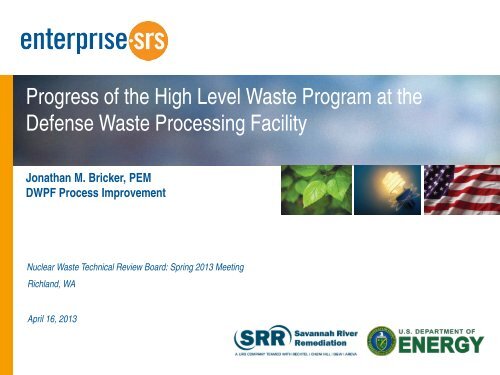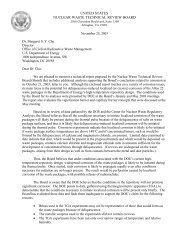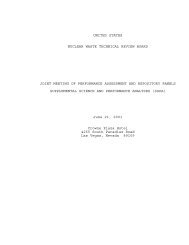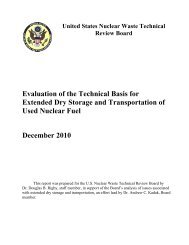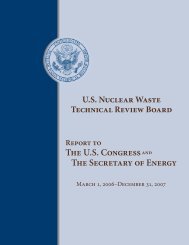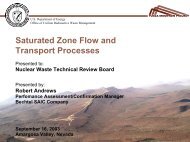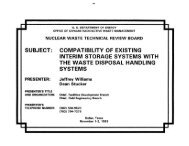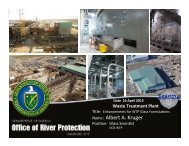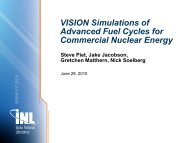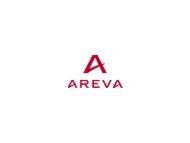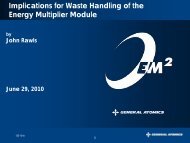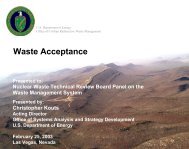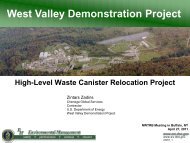Jonathan Bricker - US Nuclear Waste Technical Review Board
Jonathan Bricker - US Nuclear Waste Technical Review Board
Jonathan Bricker - US Nuclear Waste Technical Review Board
You also want an ePaper? Increase the reach of your titles
YUMPU automatically turns print PDFs into web optimized ePapers that Google loves.
Progress of the High Level <strong>Waste</strong> Program at the<br />
Defense <strong>Waste</strong> Processing Facility<br />
<strong>Jonathan</strong> M. <strong>Bricker</strong>, PEM<br />
DWPF Process Improvement<br />
<strong>Nuclear</strong> <strong>Waste</strong> <strong>Technical</strong> <strong>Review</strong> <strong>Board</strong>: Spring 2013 Meeting<br />
Richland, WA<br />
April 16, 2013
DWPF Progress<br />
– 4.0 million gallons HLW treated<br />
– 14 million pounds of glass produced representing 50 million curies<br />
– 3600+ canisters filled (7500+ planned)<br />
– Currently processing Sludge Batch 7; Sludge Batch 8 to start May 2013 (18 batches planned)<br />
– Production performance for FY13 currently below target<br />
Canisters<br />
<strong>Waste</strong> Loading<br />
Number of Discrete Canisters Produced<br />
300<br />
250<br />
200<br />
150<br />
100<br />
50<br />
0<br />
264<br />
275<br />
225<br />
196<br />
192<br />
38.3%<br />
36.5%<br />
33.3%<br />
33.0%<br />
30.7%<br />
FY08 FY09 FY10 FY11 FY12<br />
Fiscal Year<br />
2
DWPF Overview<br />
Modular Caustic Side<br />
Solvent Extraction Unit<br />
(Strip Effluent, Cs-137<br />
stream)<br />
Actinide Removal<br />
Product<br />
Nitric Acid,<br />
Formic Acid,<br />
and Antifoam<br />
Additions<br />
Antifoam Additions,<br />
Decon Frit Water<br />
Additions, and Frit<br />
Additions<br />
H- Tank Farm<br />
<strong>Waste</strong> Acceptance<br />
Items/Activities<br />
Sludge Receipt<br />
and Adjustment<br />
Tank<br />
Slurry Mix<br />
Evaporator<br />
SAMPLE<br />
ANALYSIS<br />
HOLD POINT-<br />
GLASS<br />
ACCEPTABLE?<br />
Melter<br />
Feed<br />
Tank<br />
Melter<br />
Process works to produce highly durable borosilicate wasteform.<br />
3
Recent Improvements<br />
• Extensive improvements made to increase waste throughput<br />
– Reduction in cycle time of melter feed preparation cycle (e.g. analytical improvements)<br />
– Melter bubbler installation to increase melt rate<br />
– Increase in waste loadings due to “tailoring” frit (i.e. more waste in each can)<br />
400<br />
Goal is to maximize<br />
waste throughput to<br />
reduce environmental risk.<br />
Canisters Per Year<br />
350<br />
300<br />
250<br />
200<br />
150<br />
100<br />
Recent<br />
Improvements<br />
Original<br />
Capacity<br />
Melter<br />
Bubblers<br />
Original<br />
Capacity<br />
50<br />
0<br />
DWPF Batch Prep<br />
DWPF Melter<br />
4
Challenges and Future Work<br />
• Growing need to provide flexibility to accommodate variability in<br />
SRR System Plan (e.g. waste feed compositions, input streams)<br />
– Understand and expand operating windows (simplify process to improve throughput)<br />
– Optimize processing windows for future waste compositions (higher waste loadings)<br />
– Addressing demand for higher process/equipment reliability due to closely Long-term coupled<br />
operations and increased activity in Tank Closure efforts and salt waste Improvements processing<br />
• Alternate Reductant<br />
• Dry Frit<br />
• System Reliability<br />
Goal is to position<br />
facility for continuous<br />
success.<br />
Canisters Per Year<br />
400<br />
350<br />
300<br />
250<br />
200<br />
150<br />
100<br />
50<br />
Melter<br />
Bubblers<br />
Planned<br />
Improvements<br />
Recent<br />
Improvements<br />
Original<br />
Capacity<br />
Short-term<br />
Improvements<br />
Melter<br />
Bubblers<br />
Original<br />
Capacity<br />
0<br />
DWPF Batch Prep<br />
DWPF Melter<br />
5
Lessons Learned<br />
• Lessons learned over 18 years of operation<br />
– Efficiency of waste qualification program<br />
– Success of statistical process control (versus product quality control) methodology<br />
– Decontamination features provide ability to perform hands-on work on critical<br />
equipment<br />
– Utility of maintaining research facilities and expertise throughout the DWPF production<br />
life to address immediate issues as well as forward-looking improvements<br />
– Synergizing ideas from multiple technology organizations<br />
– Continuous improvement required to accommodate changes in SRR System Plan<br />
– Understanding impacts of changes in processes on the physical properties of material<br />
– Volume management critical to vitrification production performance<br />
6


